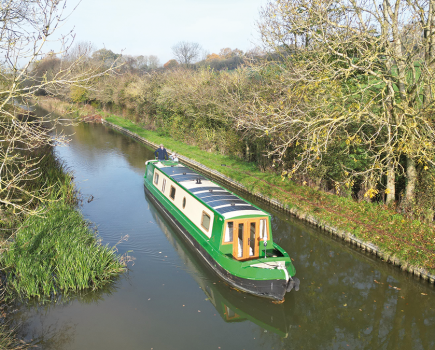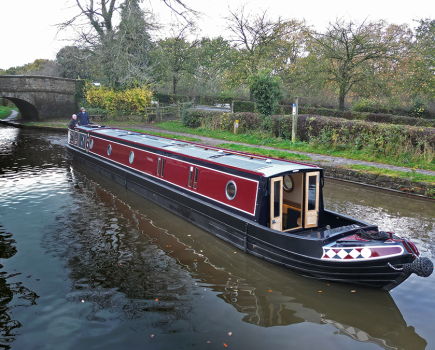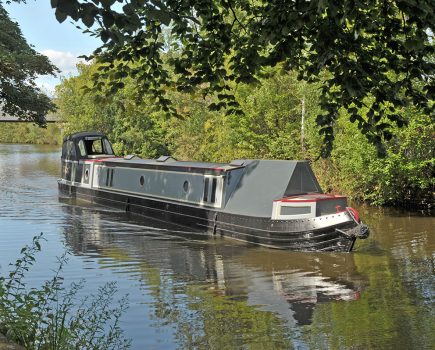Why wait years for a bespoke build? Adam braves the last blast of winter to test a top notch spec boat that is ready to go

With spring in the air, the number of people thinking about having a boat built goes up a bit. But one of the problems with commissioning a new build is the length of time it takes. Some builders have waiting lists of up to two years for a build slot, but even in a best case scenario you’ll be waiting several weeks for a shell to be built, and then at least a couple of months for the fitout to be completed.
One way of avoiding the wait is to look for a spec boat — a boat built on spec, to a standard spec. If your needs are relatively straightforward, a spec boat can be a good way of getting a high quality boat at a reasonable price in a quick timeframe. Some bespoke builders put the occasional spec boat into their schedules, but Phil Herrington at Stem To Stern has decided to take a different approach.
Phil has room in his workshop for two boats, so his idea is to build bespoke and spec boats alongside each other. It makes sense, because it will make efficient use of labour as well as space. His first spec boat had gone into the water just a few days before we went to look at it.

EXTERIOR
This 57ft boat is based on a shell by Bourne Boats, who are perhaps better known for their fitouts but who have been expanding the steelwork side of their business. It’s a good looking shell, with nice smooth sides, crisp corners, and an attractive bow featuring a very substantial stem post. There are some nice additional features, such as a planking effect on the deck at the stern.

It’s a semi-trad boat with lockers both sides of the rear deck. One of these provides storage, while the other is the gas locker. The floor has been lowered so it can take full size 13kg bottles. The position makes sense, as this boat is reverse layout, so the run of gas pipes to the rear galley is short; and it’s much easier to lift a bottle out of this locker than it would be from a locker in the nose.
This decision means the locker at the bow can be used for storage. There’s also another locker on the well deck, which also provides somewhere to sit; the base lifts up to give access to the bow thruster. A stainless steel water tank is under the deck. The well deck isn’t the biggest we’ve seen, but there would still be room to relax on a summer evening.
Stem To Stern does its painting in house, using a two pack system. The boat is painted in two shades of grey, trimmed with red handrails. It’s a contemporary looking colour scheme which works well. All the window frames, mushroom vents and other trim are in a chrome finish to complement the modern look.

LAYOUT AND FITOUT
This is a reverse layout boat with the galley at the stern. Moving forward, there’s an L-shaped dinette which is open plan to the saloon. A walk-through shower room comes next, with the cabin at the bow.

The fitout uses oak faced panels below the gunwales, and solid oak trim. Above the gunwales, the cabin sides are made from panels painted in an off-white colour, to give a bright modern look. They’re spray painted, so the finish is very smooth. Hardwearing Karndean vinyl tiles are used on the floor in the galley and shower room, while the saloon and cabin are carpeted.
GALLEY

Three steps take you from the stern deck down into the galley. The treads lift, and the top step contains two bins, for rubbish and recycling. It’s a neat solution to the perennial problem of where to fit a bin in a small galley. The bottom step gives access to the cabin bilge. Either side of the steps are cupboards, one of which contains the electrics including fuses and the inverter.
The galley itself is very smart, with dark grey painted doors on the units; the 12 volt Inlander fridge (which has an ice box at the top) was chosen mostly because its colour matched. The worktops are made from a composite material, but Phil shapes them in-house to avoid any delays caused by outside companies. They are incredibly hard wearing, and include a routed drainer next to the sink. The cooker is a slot-in model by Dometic, which has an oven and grill, and a useful storage space at the bottom.
Phil Herrington has tried to make this spec boat versatile, and a good example of this is the cupboard at the end of the L-shaped run of units. The shelf inside is removable, and the plumbing and wiring is in place for a small washing machine, should the buyers want to add one. In addition, the cupboard is on the boat’s centre line so the extra weight won’t affect the trim. It’s forward thinking like this which makes this boat stand out from the crowd.

DINETTE AND SALOON
The L-shaped dinette is a full two metres long, so offers plenty of seating, and converts into a full length bed. For that conversion, the table is removed, but doesn’t have to be used to form the bed base; instead, a slatted wooden section pulls out. In addition, there’s storage in the base, and a power point is fitted to the end, making it a convenient place to sit with a laptop or tablet. Some of the sockets throughout the boat include USB ports. There’s a set of side doors opposite the dinette, always a welcome feature.

The saloon is mostly left open for freestanding furniture. There is a corner unit with under-gunwale shelves and a large cupboard. Future options have been thought about here, too: there’s an aerial point and power for a tv, which could either sit on top of the unit, or replace the removable shelves if you wanted the tv below the gunwales. There are LED lights throughout, and they’re double switched, so they can be turned on and off from either end of the room.
The solid fuel stove is a Morso Swift. It has the Morso double wall flue fitted, and sits on a piece of granite which is 30mm thick. There are split granite tiles behind the stove.

SHOWER ROOM
The shower room is another smart and well appointed space. The shower cubicle itself is a good sized 800mm quadrant. The lining is a laminate shower wall, and the shower tray has the waste cleverly hidden in the corner. Alongside, there are some shelves between the shower and the cabin side, for towel storage.
On the opposite side of the room is an attractive unit, built in house, and painted the same grey as the galley units. On top sits a basin moulded into the worktop, and there’s a huge mirror above. The Vetus macerator loo is also incorporated into this unit, meaning the room has a cohesive look. The tank is under the head end of the bed, immediately beyond the bulkhead, meaning the length of pipe between the two is minimised. Anyone who’s had to deal with a blockage in a pump-out system will appreciate this. In addition, solid pipe is used rather than the flexible hoses which can deteriorate more quickly. The position of the tank at one end of the bed means it strays slightly off the centre line which could affect the trim of the boat as it fills. However, the effect should be fairly slight, and the upside is that storage under the bed is more accessible.

There’s a very smart grey heated towel rail, and the colour means it actually gives out more heat than a chrome one of the same size. The doors at either end of the room are both solid oak, and have magnets to hold them open. The light is combined with an extractor fan, but they’ve been wired separately so you can turn the light on without the fan starting up.
CABIN

The bed is in-line, and has plenty of storage in the base (thanks at least in part to the way the loo tank is positioned). There are drawers in the side of the base, and longer term storage is available on the far side.
Above the head of the bed is a decent sized cupboard, whose top is arched to match the curve of the ceiling. There are reading lights set into the bottom of the unit, which are turned on and off by touch.
At the foot of the bed is a large wardrobe, with a hanging rail. This also has power and an aerial socket, so a tv could be mounted on the side of the unit if required. There’s more storage in the bottom step which leads up to the bow deck; the second step (which is triangular) contains the water pump. On the opposite side of the boat is a curvy shelf.

TECHNICAL
This boat is powered by a Vetus 4.45 engine, which is a 42hp model. This latest version of the engine has been given a cast aluminium top cover, which the firm claims reduces the temperature of the engine and makes it quieter. It’s also designed to act as a step, so you can safely stand on the engine to get into the engine hole. There’s plenty of room around the engine, and even though there are lockers both sides of the stern deck, access to the engine hole is fine, so servicing should be fine. In the unlikely event of a fire, the engine board has a fire port fitted, so it can be tackled without having to lift the board. The bow thruster is also by Vetus, a 55kgf model.

Electrical power comes from four 120Ah domestic batteries (plus one for the engine, and another at the bow for the bow thruster). A 240 volt supply comes from a Mastervolt 2.2kw inverter. It comes with one of the firm’s EasyView monitors, which shows on a colour touchscreen all sorts of information, including the state of charge of the batteries, how much power is being used, and how much has been used since the last charge.
In another nod to future proofing, the boat has the cabling for solar panels in place, so installing a solar array on the roof should be fairly simple.
Heating is from a Webasto diesel boiler, and there’s a seven day timer complete with a thermostat by the dinette.
Stem To Stern use an independent surveyor to monitor the build, ensure it complies with the latest regulations, and produce the owner’s manual.
ON THE WATER
Our trip on this boat was fairly restricted in length but did include spinning it around several times — so I can say without hesitation that it turns extremely well. In general, the boat goes exactly where it’s pointed and responds well to the tiller. The bow thruster is powerful enough to move the boat off a jetty against a stiff breeze.
The engine sounds smooth and quiet, and when at the helm the tiller is at a comfortable height and the Morse control falls easily to hand. The dials are clearly visible from the steering position too.
The lockers each side of the stern deck provide somewhere for crew to sit, although having the galley doors open does restrict the room somewhat. Designs we’ve seen to get around this include shaping the lockers to allow the doors to swing right back (which might not be possible here as one is a gas locker) or splitting the doors, so the top half can move independently. It’s hardly a huge issue, though.
CONCLUSION
This is a very well built boat, which would suit the needs of many boaters. The reverse layout is popular and works well with a semi-trad stern, while the quality of the fitout is extremely high. All the furniture is nicely built with some excellent joinery on show. What’s more, it’s good to see a spec boat which gives the owners the opportunity to easily add more equipment. To have power, plumbing, and cabling in place for a washing machine, TVs, and solar panels is a real positive. All in all, it’s a package which will easily meet the requirements of a big proportion of boaters.
The price is a touch under £130,000. That’s more than some off the peg standard boats available, but a lot less than many of the bespoke boats we look at. It’s a fair price for a boat of this quality, and with this level of equipment.
And of course a major plus for a spec boat like this is that it’s available straight away. You could, if you were so inclined, pay your money and cruise it away right now, without any waiting. And when spring is in the air and you just want to get boating, that can only be a good thing.
STEM TO STERN
Phil Herrington has been building boats for more than fifteen years. His background is in joinery and shop fitting, but he first started building boats in 2001. He had a successful business, including building a range of wide beams sold through a well known boat retailer. But in 2008, when the financial crisis hit, he had a number of orders cancelled, and decided to put the business on hold.
Over the next few years he worked for Piper Boats, and in fact still works for the company on occasions. But in 2013 he started building a boat for himself and his family, and the appeal of being his own boss proved attractive. That boat ended up being sold, as the start of the renewed business. In 2016, Stem To Stern reappeared at the Crick Boat Show, and since then Phil has had other bespoke commissions.
The plan to produce a spec boat alongside bespoke ones makes business sense, and Phil hopes to have one on the go pretty much all the time. The next one is due to be at this year’s Crick Show — it will be similar but not identical to this boat.
TECHNICAL SPECIFICATIONS
Stem To Stern Ltd
Unit 8 Leons Way, Tollgate Industrial Estate, Stafford ST16 3EE
01785 257272 www.stemtostern.co.uk
Length: 57ft
Beam: 6ft 10in
Shell: Bourne Boat Builders
Style: Semi-trad
Layout: Reverse
Berths: 2+2
Fit-out: Oak and painted panels
Engine: Vetus 4.45
Inverter: Mastervolt 2.2kw
Bow Thruster: Vetus 55kgf
DESIGN AND DECOR
Galley worktops: LG Hi-macs £prices vary
Stove: Morso Swift £657
Cooker: Dometic www.marinestore.co.uk CU400 £835
Battery monitor: Mastervolt EasyView5 £308
Total Price: £129,950
Image(s) provided by:
Archant







